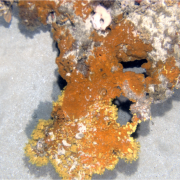July 4, 2012
A team of NERP Marine Biodiversity Hub researchers from the University of Tasmania, Geoscience Australia and CSIRO has been testing new monitoring approaches in phase one of the Flinders Marine Reserve field survey.
The team, led by Dr Keith Hayes of CSIRO, is trialling a Generalized Random Tessellation Stratified (GRTS) Spatially-Balanced Survey design across the Flinders shelf, and comparing this approach with the more usual method of smaller-scale, continuous swath-mapping. They will compare estimates of shelf habitat types derived from the different survey approaches, and their suitability for identifying monitoring locations on hard (reef) and possibly mixed habitat locations.
A second phase of the survey will deploy stereo towed video and Baited Remote Underwater Video (BRUVs) to map biological assets in the reserve, and examine survey design and statistical issues such as spatial correlation between BRUVs.
Dr Jeff Dambacher of CSIRO says GRTS survey design ensures sample sites are evenly dispersed through space, avoiding the clumping of random site selection. The approach also exploits natural spatial patterns: an effective means of increasing the information derived from monitoring.
Dr Dambacher says GRTS design is well established in North America for land-based surveys, but has not been adapted to open ocean sea-floor habitats. He says ship-based sampling presents interesting challenges, and Marine Hub biologists and statisticians have been working together to plan surveys in the Flinders, Solitary Islands, and Houtman-Abrolhos reserves.
Technical advice on GRTS survey design has been provided to the Marine Hub, the Department of Sustainability, Environment, Water, Population and Communities, and the Institute for Marine and Antarctic Science Studies by its developer, Professor Don Stevens of Oregon State University. In April, Professor Stevens outlined his experiences of long-term monitoring programs and addressed local concerns. The exchange highlighted the need to identify operational objectives for planning regions, and to identify and prioritise monitoring questions for reserves.
Marine Hub Director, Professor Nic Bax, says monitoring will be a key aspect of adaptive management for Australia’s proposed Commonwealth Marine Reserve Network. He says efficient, standardised monitoring building on existing data streams will provide the necessary information and tools. The Hub is working with existing data providers, including the Integrated Marine Observing System, to identify information that will support adaptive management.
Images:
- Diversity on the deeper shelf reefs in Flinders Commonwealth Marine Reserve - massive sponge and encrusting sponges. (Images taken by Autonomous Underwater Vehicle)
- Iron-rich rock outcropping across the shelf in about 80 m

Further reading:
- Proposed Commonwealth Marine Reserve Network for Australia
- Stevens, D. L., Jr, and Olsen, A. R. (2004) Spatially balanced sampling of natural resources. Journal of the American Statistical Association 99:262–278.
Contact:
Dr Keith Hayes, CSIRO
- Log in to post comments
